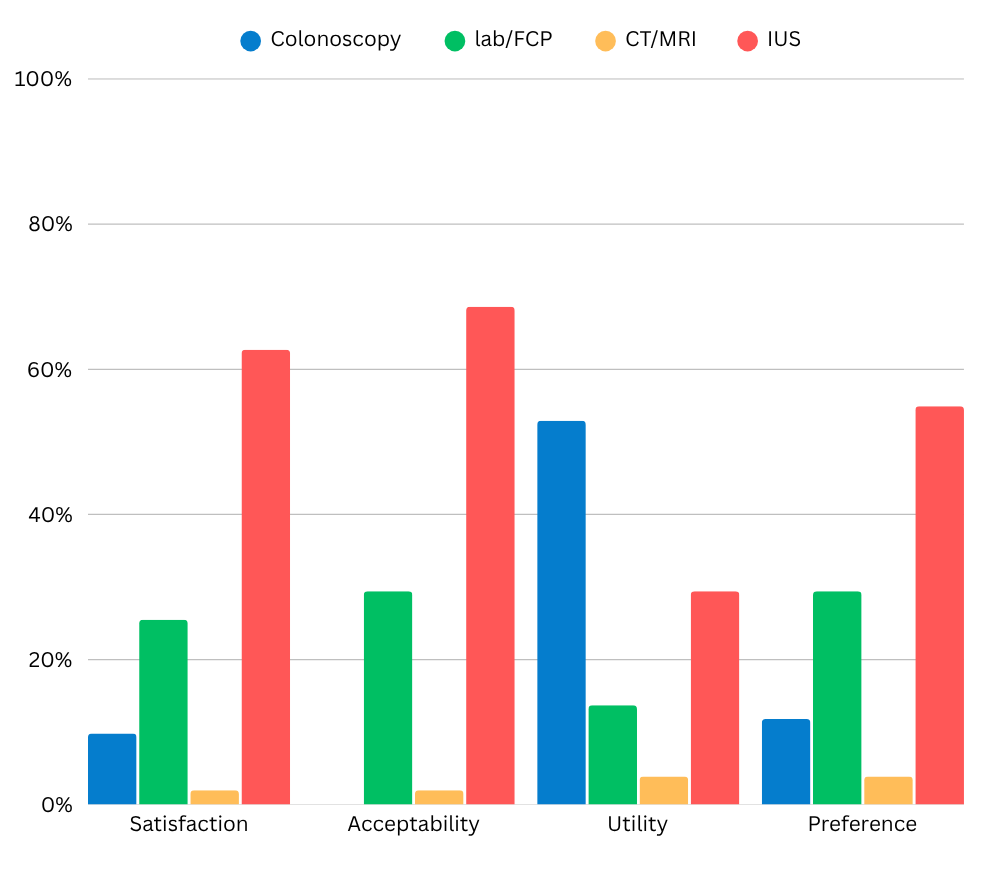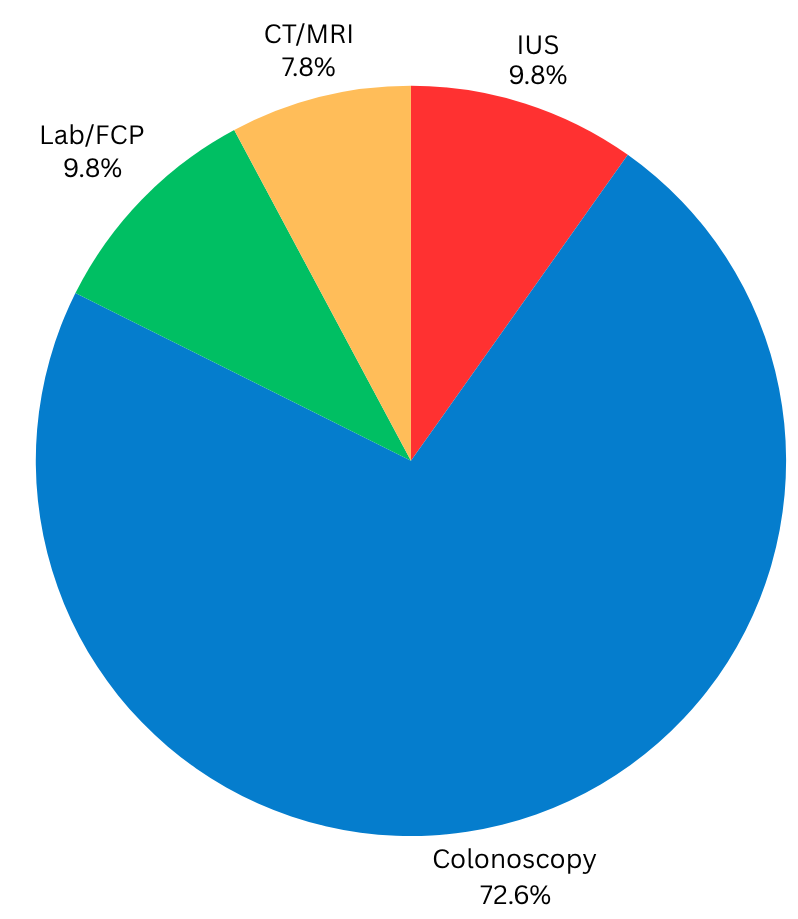Monday Poster Session
Category: IBD
P3251 - Patient Preferences and Perceptions for Inflammatory Bowel Disease Monitoring Tools: A Survey from a Gastroenterology Clinic in Panama
Monday, October 27, 2025
10:30 AM - 4:00 PM PDT
Location: Exhibit Hall

Valeria Orillac, MD
Gastroenterólogos Asociados - Unidad de Investigacion en Enfermedades Digestivas - Pacifica Salud
Panama, Panama, Panama
Presenting Author(s)
Valeria Orillac, MD1, Carlos Rettally, 2
1Gastroenterólogos Asociados - Unidad de Investigacion en Enfermedades Digestivas - Pacifica Salud, Panama, Panama, Panama; 2Gastroenterólogos Asociados - Pacifica Salud, Panamá, Panama, Panama
Introduction: IBD requires ongoing monitoring to assess disease activity and guide treatment. Common tools include colonoscopy, intestinal ultrasound (IUS), abdominal CT/MRI, and laboratory testing with fecal calprotectin (lab/FCP). Despite routine use, data on patient perceptions remain limited. Understanding satisfaction, acceptability, and perceived utility may help optimize monitoring and support shared decision-making. This study aimed to evaluate patient preferences and perceptions regarding common IBD monitoring tools in a private gastroenterology clinic in Panama.
Methods: This cross-sectional study used an anonymous electronic survey distributed to 82 eligible IBD patients (≥18 years) with follow-up within the past two months. The questionnaire assessed four modalities–colonoscopy, IUS, CT/MRI, lab/FCP–across four domains: satisfaction, acceptability, perceived utility, and overall preference. Participants selected their preferred modality for each domain. Descriptive statistics were used.
Results: Fifty-one patients completed the survey (response rate: 62.2%.); 58.8% were female, median age of 38 years. Of them, 64.7% had Crohn’s disease and 35.3% ulcerative colitis. All had undergone colonoscopy, 90.2% IUS and lab/FCP, and 49% CT/MRI. Satisfaction was highest for IUS (62.7%), followed by lab/FCP (25.5%), colonoscopy (9.8%), and CT/MRI (2%). Acceptability was also highest for IUS (68.6%), followed by lab/FCP (29.4%), while colonoscopy received 0% and CT/MRI only 2%. Perceived utility to understand disease status was highest for colonoscopy (52.9%), followed by IUS (29.4%), lab/FCP (13.7%) and CT/MRI (3.9%). Most patients (72.5%) believed colonoscopy provided physicians the most useful information; only 9.8% said the same for IUS. If required to repeat one test, 54.9% preferred IUS, followed by lab/FCP (29.4%), colonoscopy (11.8%), and CT/MRI (3.9%).
Discussion: Patients reported high satisfaction, acceptability and preference for IUS, aligning with comfort and willingness to repeat. However, most still viewed colonoscopy as the standard for physician assessment. This gap highlights the need for educational interventions to improve patient understanding of IUS clinical value. Integrating patient perspectives through shared-decision making may enhance satisfaction, support adherence, and promote more effective, individualized IBD management.

Figure: Patient Rating for IBD Monitoring Tools Across Four Domains

Figure: Perceived Utility for the Physician
Disclosures:
Valeria Orillac indicated no relevant financial relationships.
Carlos Rettally indicated no relevant financial relationships.
Valeria Orillac, MD1, Carlos Rettally, 2. P3251 - Patient Preferences and Perceptions for Inflammatory Bowel Disease Monitoring Tools: A Survey from a Gastroenterology Clinic in Panama, ACG 2025 Annual Scientific Meeting Abstracts. Phoenix, AZ: American College of Gastroenterology.
1Gastroenterólogos Asociados - Unidad de Investigacion en Enfermedades Digestivas - Pacifica Salud, Panama, Panama, Panama; 2Gastroenterólogos Asociados - Pacifica Salud, Panamá, Panama, Panama
Introduction: IBD requires ongoing monitoring to assess disease activity and guide treatment. Common tools include colonoscopy, intestinal ultrasound (IUS), abdominal CT/MRI, and laboratory testing with fecal calprotectin (lab/FCP). Despite routine use, data on patient perceptions remain limited. Understanding satisfaction, acceptability, and perceived utility may help optimize monitoring and support shared decision-making. This study aimed to evaluate patient preferences and perceptions regarding common IBD monitoring tools in a private gastroenterology clinic in Panama.
Methods: This cross-sectional study used an anonymous electronic survey distributed to 82 eligible IBD patients (≥18 years) with follow-up within the past two months. The questionnaire assessed four modalities–colonoscopy, IUS, CT/MRI, lab/FCP–across four domains: satisfaction, acceptability, perceived utility, and overall preference. Participants selected their preferred modality for each domain. Descriptive statistics were used.
Results: Fifty-one patients completed the survey (response rate: 62.2%.); 58.8% were female, median age of 38 years. Of them, 64.7% had Crohn’s disease and 35.3% ulcerative colitis. All had undergone colonoscopy, 90.2% IUS and lab/FCP, and 49% CT/MRI. Satisfaction was highest for IUS (62.7%), followed by lab/FCP (25.5%), colonoscopy (9.8%), and CT/MRI (2%). Acceptability was also highest for IUS (68.6%), followed by lab/FCP (29.4%), while colonoscopy received 0% and CT/MRI only 2%. Perceived utility to understand disease status was highest for colonoscopy (52.9%), followed by IUS (29.4%), lab/FCP (13.7%) and CT/MRI (3.9%). Most patients (72.5%) believed colonoscopy provided physicians the most useful information; only 9.8% said the same for IUS. If required to repeat one test, 54.9% preferred IUS, followed by lab/FCP (29.4%), colonoscopy (11.8%), and CT/MRI (3.9%).
Discussion: Patients reported high satisfaction, acceptability and preference for IUS, aligning with comfort and willingness to repeat. However, most still viewed colonoscopy as the standard for physician assessment. This gap highlights the need for educational interventions to improve patient understanding of IUS clinical value. Integrating patient perspectives through shared-decision making may enhance satisfaction, support adherence, and promote more effective, individualized IBD management.

Figure: Patient Rating for IBD Monitoring Tools Across Four Domains

Figure: Perceived Utility for the Physician
Disclosures:
Valeria Orillac indicated no relevant financial relationships.
Carlos Rettally indicated no relevant financial relationships.
Valeria Orillac, MD1, Carlos Rettally, 2. P3251 - Patient Preferences and Perceptions for Inflammatory Bowel Disease Monitoring Tools: A Survey from a Gastroenterology Clinic in Panama, ACG 2025 Annual Scientific Meeting Abstracts. Phoenix, AZ: American College of Gastroenterology.
